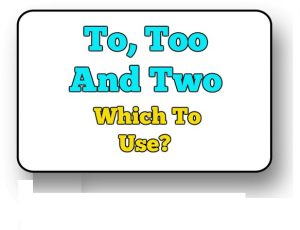To, Too And Two – Which To Use?
 When it comes to homophones (two or more words that sound or are spelled the same, but have different meanings) there are always problems. They can present issues to students and English writers all over the world. A set of homophones that often cause difficulties when it comes to choosing them are To, Too and Two.
When it comes to homophones (two or more words that sound or are spelled the same, but have different meanings) there are always problems. They can present issues to students and English writers all over the world. A set of homophones that often cause difficulties when it comes to choosing them are To, Too and Two.
Even auto-correct or spell checking programs at times have problems detecting improper use of them. All three of these homophones are are pronounced in the same manner and are almost identical in spelling. Save for two which is the easiest of the three to differentiate. Nonetheless, to, too and two and which to use is worth looking at.
To –
The word To is used for indicating an action, movement or suggestive condition. This is usually towards a person, place or thing. It is also used to express motion, direction or as an adverb. It can be also used to demonstrate an intention, purpose, result or tendency.
You may also want to read The Difference Between Theirs And Their’s
Some examples of when to use To correctly:
He came to our aid when he saw we were in distress.
Did she come to our house last night?
And to think that I used to really like him at one point!
Have him call me when he comes to his senses.
Please, come back to me my love!
Too –
If you want to describe something that’s an addition, then Too comes in handy. When used as and adverb, it is another way of saying ‘as well’ ‘besides,’ or ‘also’. Too is a form of words such as ‘moreover,’ ‘in addition,’ and ‘furthermore.’ Too is also used when referring to some an extent or a degree.
Some examples of when to use Too correctly:
It it too bad that Harry never bothered to apply for that job.
You would be delighted too if he had given you such a nice gift.
I tried talking to her but she did not seem too interested.
Lisa wanted to work out but she was too tired to run.
Two –
Unlike To and Too, the word Two is actually very easy to tell apart from the trio. Since Two represents a number or a numerical value, it is not that easy to confuse or use improperly. Two can also be used when referring to splitting something into separate parts or into halves.
Some examples of when to use Two correctly:
The last two people off the bus will have to wait in line longer.
These two items are identical but do not cost the same.
I cut the orange into two pieces; one for me, the other for you.
Yes, you are right. Two is better than one!
Don’t forget to check out The Difference Between Homonyms, Homophones And Homographs
To and Too are often confused with each other more than Two. As we pointed out, that is due to not only the spelling, but the meaning. Two is the easiest of the three to tell apart. When it comes to homophones, remember this rule. You can either learn to remember the easiest of the words first. This will allow you to tell one from the other when faced with using either of them. Or you can concentrate on learning to use the word which causes the most difficulty for you. Once you learn to properly use that one, the other will become easier to deal with and use properly.
